What Is Modified Bitumen Roofing (Mod Bit)?
Modified bitumen roofing is a type of asphalt-based roofing system that uses membranes modified with additional polymers or fabrics to provide a durable, versatile, and weather-resistant surface for flat or low-slope roofs. The modification process enhances its flexibility, strength, and resistance to harsh environmental conditions. Modified bitumen roofing is used for both commercial and residential flat roofs.
History of Modified Bitumen Roofing
Modified bitumen roofing originated in Europe in the mid-1960s as an improvement to traditional built-up roofing systems (BUR). It was introduced to the United States in the 1970s and gained popularity due to its enhanced durability and weather resistance.
Composition of Modified Bitumen Roofing
Modified bitumen roofing is composed of bitumen, which is a sticky, black, and highly viscous substance derived from crude oil. This bitumen is then reinforced with materials like fiberglass or polyester to enhance its strength and durability. The most common polymers used in modified bitumen roofing are styrene-butadiene-styrene (SBS) and atactic polypropylene (APP). Additionally, some modified bitumen roofs have a surfacing material, which can be granules, foil, or a coated surface, to provide added protection against elements like UV rays and fire.
Components of Modified Bitumen Roofing System
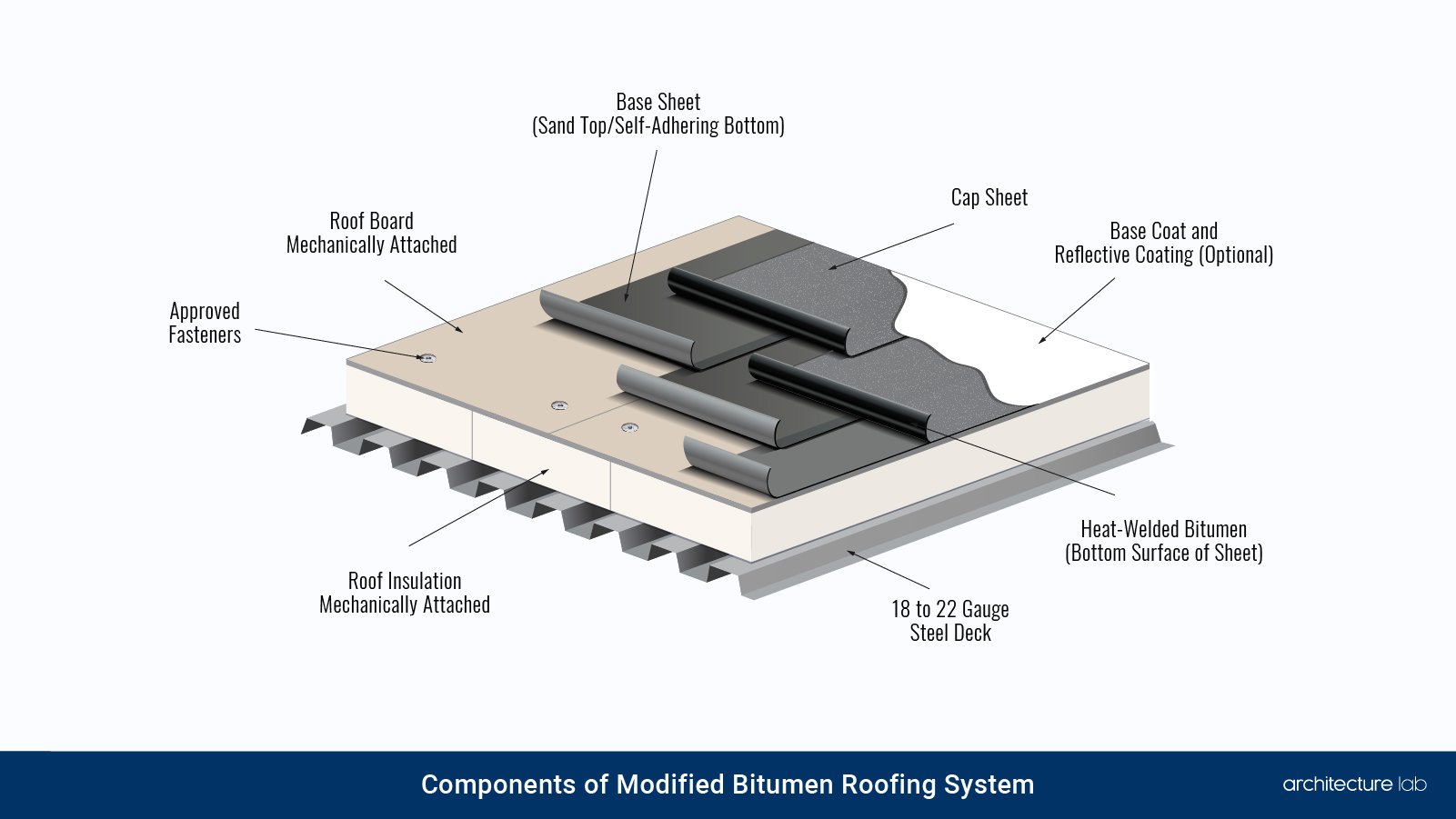
- Bitumen Membrane: The bitumen membrane forms the core of the roofing system, creating a watertight barrier that shields the underlying structure from moisture and environmental elements.
- Reinforcement Material: Comprising either fiberglass or polyester, the reinforcement layer fortifies the bitumen membrane, providing crucial strength and durability, while preventing stretching or tearing.
- Surfacing Material: The top layer of the modified bitumen membrane can feature granules, foil, or a coated surface, offering additional protection against UV rays, fire, and other potential sources of damage.
- Adhesive: This essential component ensures a secure bond between the layers of the modified bitumen membrane during installation, creating a seamless and waterproof surface.
- Flashing: Flashing is strategically used to seal joints, edges, and vulnerable areas of the roofing system, preventing water infiltration through gaps or seams.
- Insulation (Optional): Optionally added beneath the modified bitumen roofing system, insulation provides thermal resistance, enhancing energy efficiency and regulating indoor temperatures.
- Decking Material: Serving as the structural foundation, the roofing deck is constructed from materials like plywood, OSB, or concrete, providing the necessary support for the entire roofing system.
- Fasteners and Anchors (if applicable): In cases where additional security is required, fasteners and anchors are used to firmly attach the roofing system to the decking, ensuring stability even in adverse weather conditions.
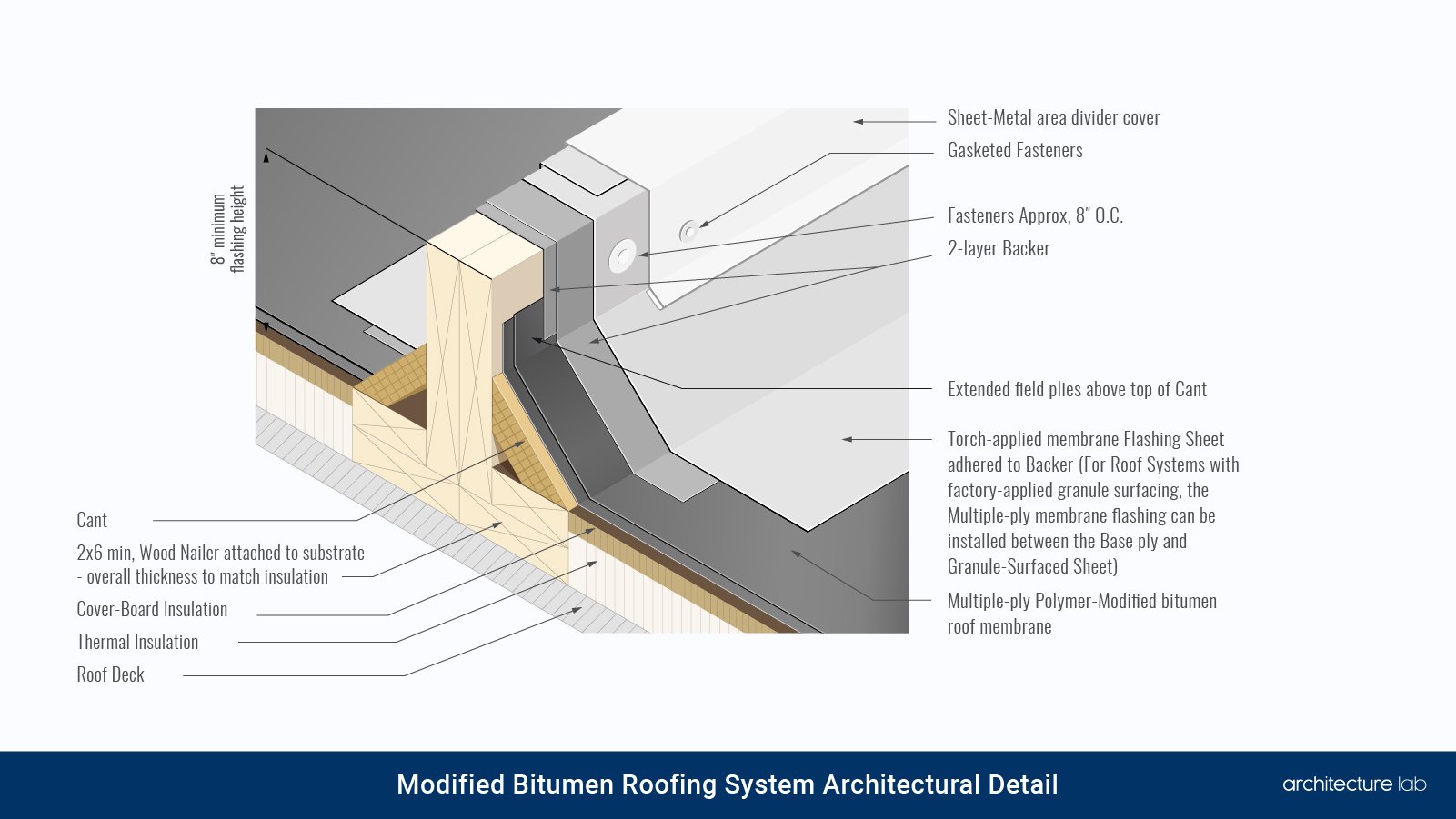
Importance of Modified Bitumen Roofing in Building Construction
Modified bitumen roofing is a crucial component in building construction due to its exceptional durability, weather resistance, and waterproofing capabilities. It serves as a dependable shield, significantly prolonging a structure’s lifespan and minimizing long-term maintenance expenses. This makes it a practical choice for ensuring a robust and resilient roofing system.
Benefits of Modified Bitumen Roofing
- Durability: Modified bitumen roofing is known for its exceptional durability, and ability to withstand harsh weather conditions and heavy foot traffic, making it a long-lasting roofing option.
- Waterproofing: Modified bitumen roofing provides superior waterproofing capabilities, preventing water from seeping into the building and protecting against water damage.
- Weather Resistance: Modified bitumen roofing is designed to withstand extreme weather elements, including UV rays, high winds, and temperature fluctuations, ensuring a reliable performance over time.
- Flexibility: Modified bitumen is flexible, allowing it to expand and contract with temperature changes without cracking or compromising its integrity.
- Fire Resistance: Modified bitumen roofing offers excellent fire resistance, providing an additional layer of safety to the building and potentially lowering insurance premiums.
- Low Maintenance: Modified bitumen roofing requires minimal maintenance over its lifespan, reducing the need for frequent repairs and upkeep costs.
- Insulation Properties: Modified bitumen roofing can provide good insulation, helping to regulate indoor temperatures and potentially lowering energy costs.
- Easy Installation: The installation process for modified bitumen roofing is relatively straightforward, especially for experienced roofing contractors, which can save time and labor costs.
- Tear Resistance: Modified bitumen roofing is less likely to tear or be damaged during installation or due to foot traffic compared to other roofing materials, providing added longevity.
Drawbacks of Modified Bitumen Roofing
- High installation cost: Modified bitumen roofing is more expensive than some other types of roofing materials, such as asphalt shingles. However, the higher initial cost can be offset by the longer lifespan and lower maintenance costs of modified bitumen roofing.
- Limited Aesthetic Options: Modified bitumen roofing typically offers fewer aesthetic choices compared to some other roofing materials, which may be a consideration for those seeking a specific look or style.
- Non-eco-friendly: Modified bitumen roofing is made from petroleum products, which are not a renewable resource. Additionally, the manufacturing process of modified bitumen roofing can release harmful pollutants into the environment.
Types of Modified Bitumen Membranes
There are 2 types of modified bitumen membranes :
1. SBS
SBS, or Styrene-Butadiene-Styrene, is a type of modified bitumen membrane known for its high flexibility and elasticity. It can adapt to temperature changes without sacrificing its structural integrity, making it an excellent choice for regions with varying weather conditions. SBS membranes are commonly used in areas prone to heavy foot traffic or structural movement.
2. APP
APP, or Atactic Polypropylene, is another popular modified bitumen membrane. It offers exceptional resistance to UV rays and high temperatures, making it suitable for regions with prolonged sun exposure. APP membranes are known for their longevity and ability to maintain their structural integrity over extended periods, providing reliable protection for buildings in hot climates.
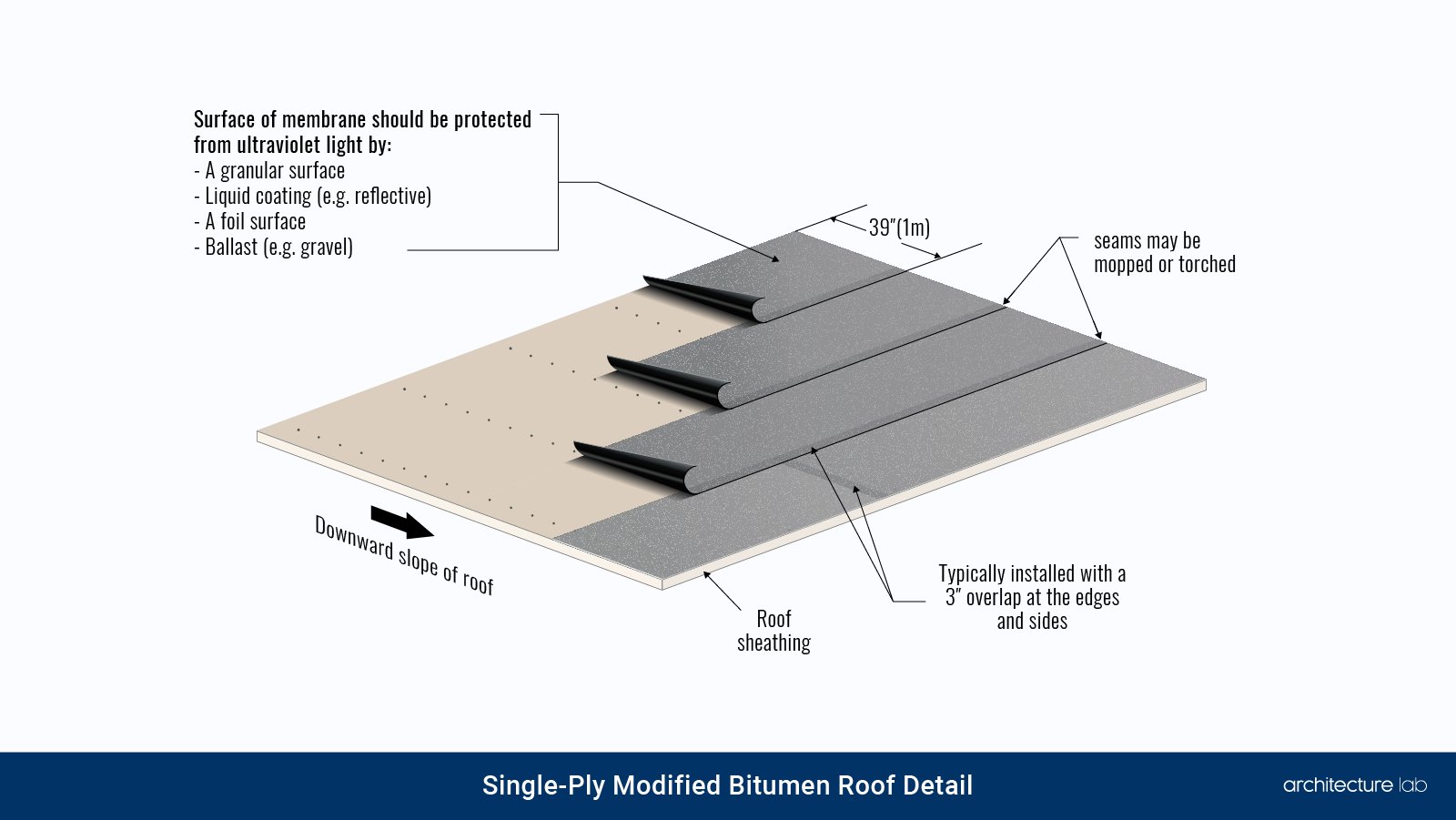
How to Choose the Correct Bitumen Membrane?
Here are some factors to consider in order to choose the correct bitumen membrane :
- Climate and Temperature Fluctuations:
Suggested Membrane: SBS
SBS membranes offer high flexibility, making them suitable for regions with varying temperature ranges.
- UV Exposure and High Temperatures:
Suggested Membrane: APP
APP membranes have excellent UV resistance and perform well in areas with prolonged sun exposure and high temperatures.
- Foot Traffic and Structural Movement:
Suggested Membrane: SBS
SBS membranes are known for their elasticity, making them a better choice for areas prone to heavy foot traffic or structural movement.
- Installation Method (Torch-Applied, Cold-Applied, Self-Adhered):
Suggested Membrane: Dependent on installer preference and expertise. Both SBS and APP membranes are available in various application methods.
- Budget Constraints:
Suggested Membrane: Depends on budget and specific project requirements. Both SBS and APP membranes have options at different price points.
- Project Consultation with Roofing Professionals or Manufacturers:
Suggested Membrane: Seek advice from professionals based on the project’s unique requirements. They may recommend either SBS or APP membranes depending on specific needs.
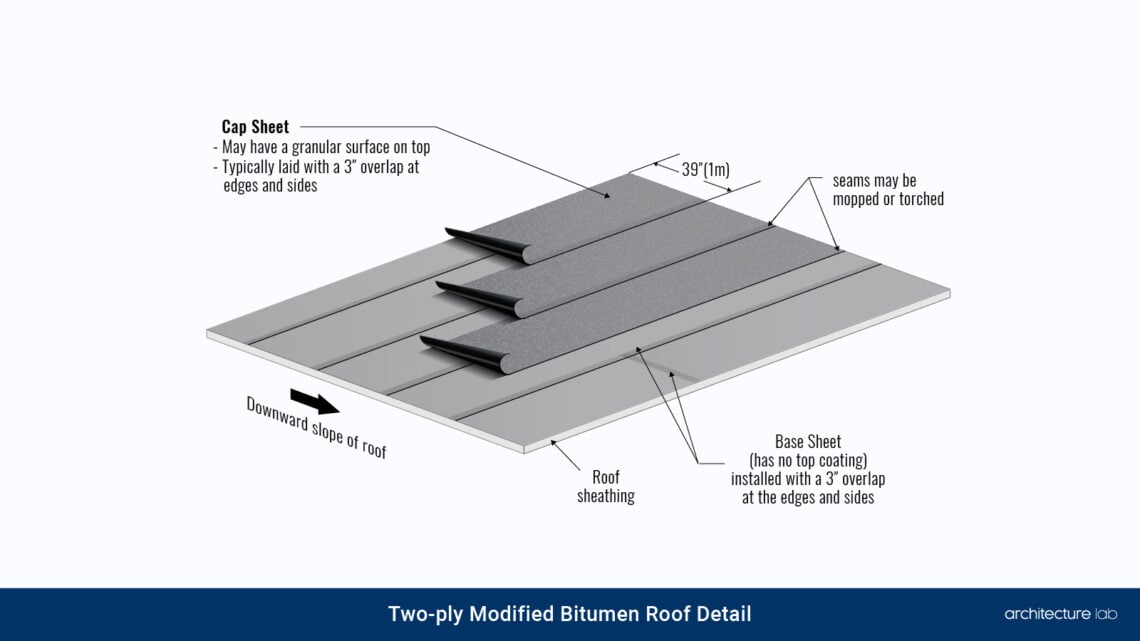
Installation Process of Modified Bitumen Roofing
Things to Consider Before Installation
- Surface Preparation: Ensure the roof deck is clean, dry, and free of debris or irregularities to promote proper adhesion of the modified bitumen membrane.
- Weather Conditions: Choose appropriate weather conditions for installation. Avoid extreme temperatures, and consider the manufacturer’s recommendations for specific climate considerations.
- Safety Measures: Implement necessary safety precautions, including proper fall protection equipment and adherence to industry-standard safety guidelines.
- Ventilation and Adequate Drainage: Ensure proper ventilation and drainage systems are in place to prevent moisture buildup and extend the lifespan of the roofing system.
- Compatibility with Existing Roofing: Assess compatibility with any existing roofing materials or systems, and make any necessary adjustments or preparations.
- Consultation with Professionals: Seek advice from experienced roofing professionals or manufacturers for specific installation techniques and best practices based on your project’s unique requirements.
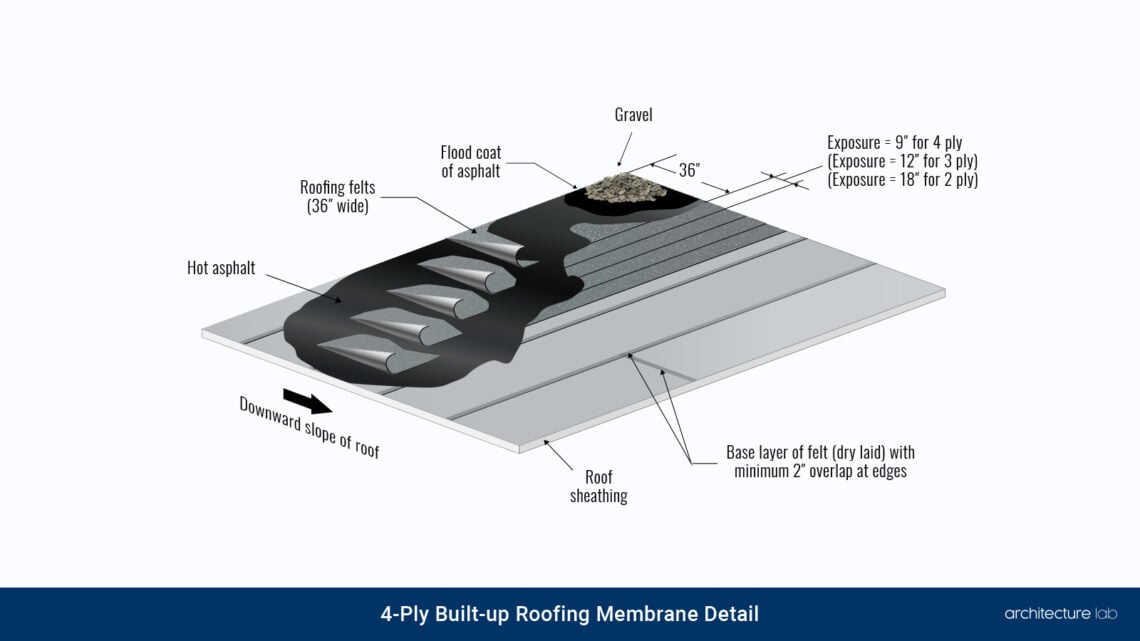
Surfacing
The choice of surfacing for modified bitumen roofing plays a crucial role in its performance and durability. There are three main options to consider:
1. Granule-Surfaced
Granule-surfaced modified bitumen offers excellent protection against UV rays and physical damage. The granules act as a shield, extending the lifespan of the roofing material. This type of surface is well-suited for areas with high sun exposure and heavy foot traffic, providing added durability and resistance against environmental elements.
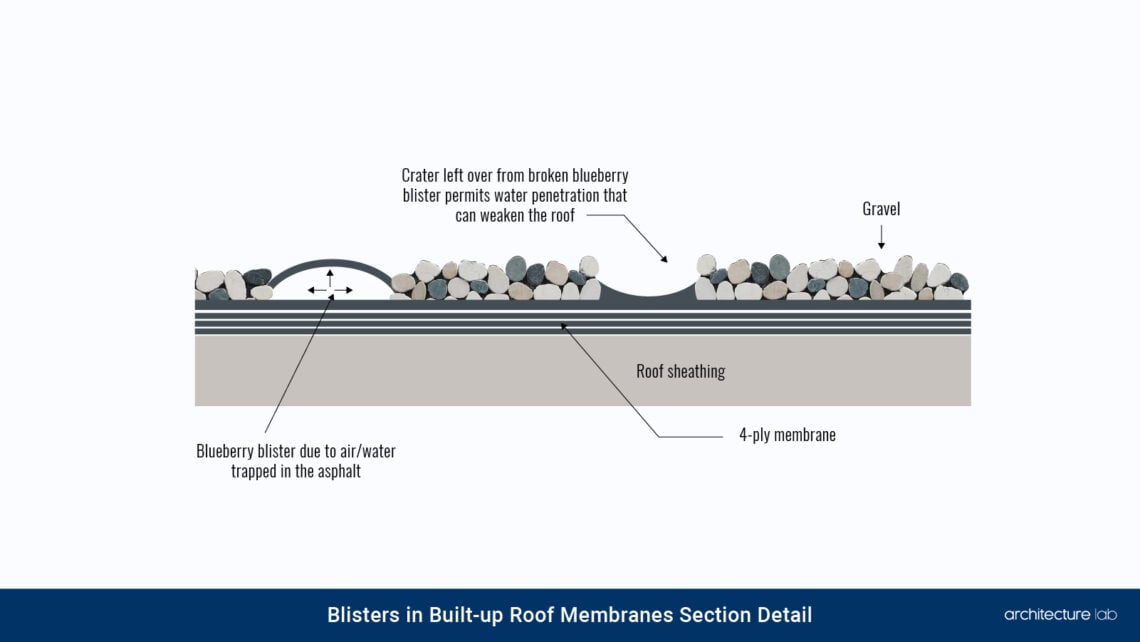
2. Foil-Surfaced
Foil-surfaced modified bitumen provides reflective properties, enhancing energy efficiency and reducing heat absorption. This type of surface is beneficial for buildings aiming to improve insulation and temperature control. The reflective foil helps to maintain a cooler interior climate, potentially leading to energy savings.
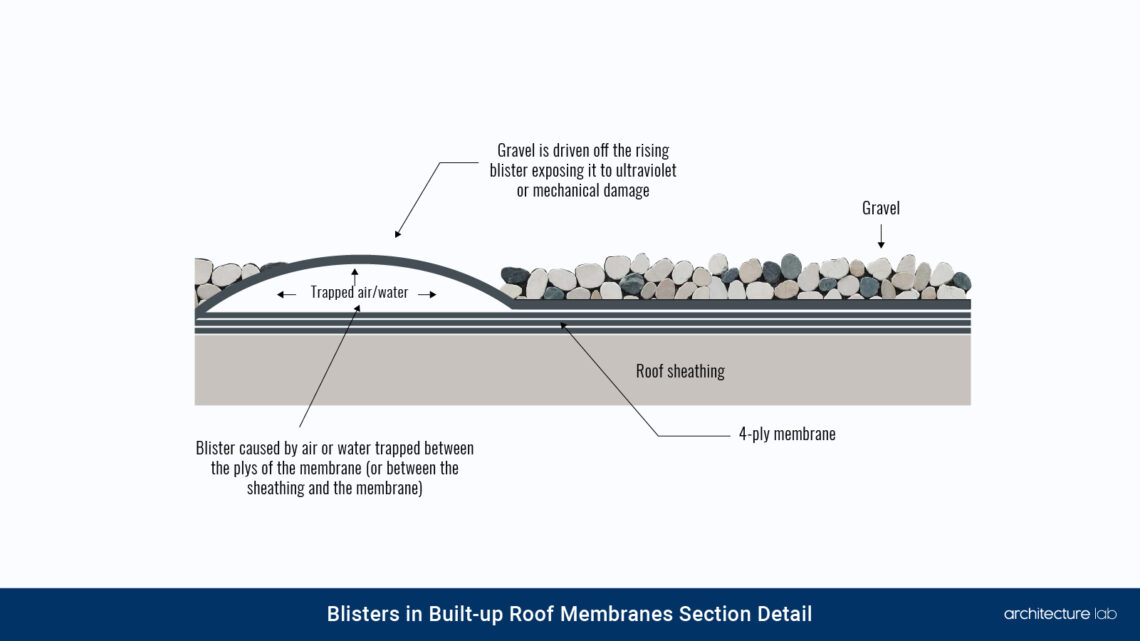
3. Coated
Coated modified bitumen roofing offers versatility and customization options. Depending on the specific coating applied, this surface can provide benefits such as enhanced waterproofing, fire resistance, or even added insulation. The choice of coating allows for tailoring the roofing system to meet the unique needs and requirements of the building.
Modified Bitumen Roofing Application Techniques and Attachment Methods
Torch-Applied (or “Heat Welded”)
In the torch-applied application method, modified bitumen membranes are attached to the roof deck using an open flame torch to melt the bottom surface of the membrane and adhere it to the substrate.
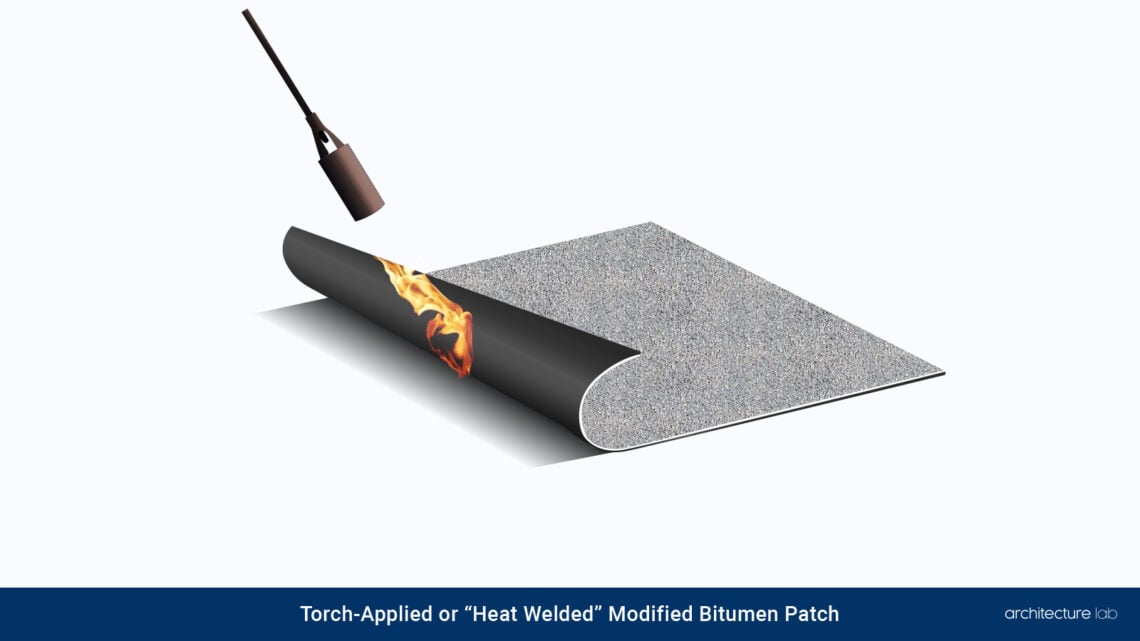
This process provides a strong and secure bond, creating a seamless and watertight surface. It is crucial to follow safety protocols and ensure proper ventilation during torch-applied installations.
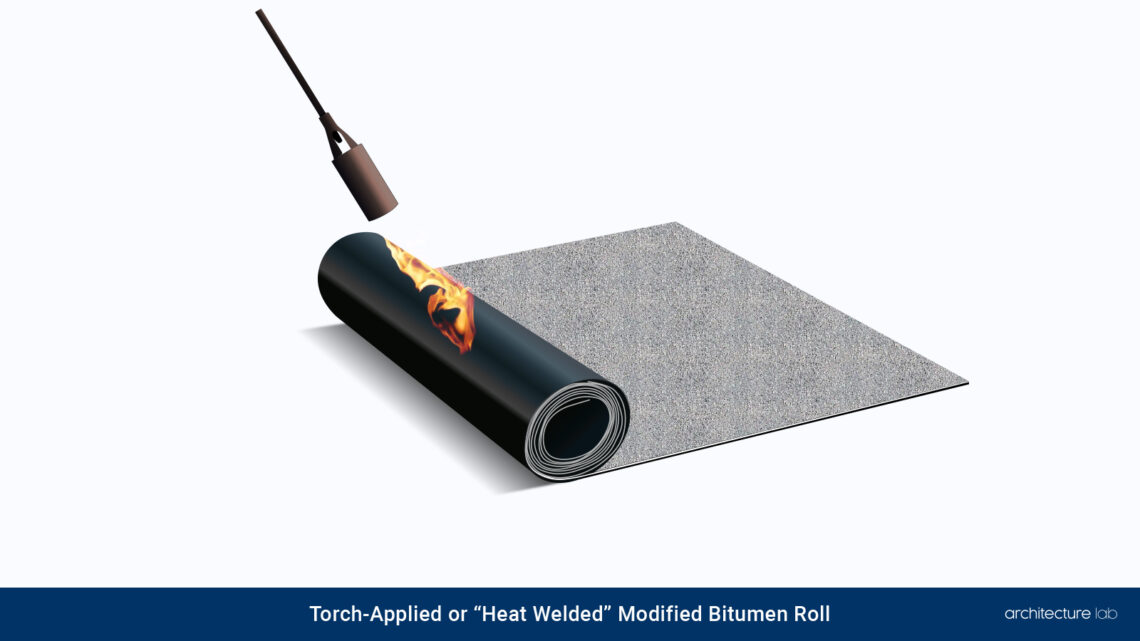
Mopped in with Hot Asphalt
The mopping method involves using hot asphalt to adhere the modified bitumen membrane to the roof deck. Hot asphalt is heated and applied to both the membrane and the substrate, creating a durable bond. This technique requires skill and experience to ensure proper coverage and adhesion, making it a common choice for professional roofing contractors.
Cold-Process Adhesive
Cold-process adhesive is a solvent-based bonding agent used to install modified bitumen roofing membranes. This method eliminates the need for heat application, making it a safer option for certain environments. The adhesive is applied to both the membrane and substrate, creating a strong and reliable bond. Cold-process adhesive is suitable for projects where torch-applied or hot asphalt methods may not be feasible.
Self-Adhering (Peel-and-Stick) Membrane
Self-adhering membranes come with a pre-applied adhesive backing that is activated by pressure during installation. This method offers ease of application, making it suitable for DIY projects or situations where torches or hot asphalt may not be practical. It provides a secure bond and is known for its simplicity and convenience in the installation process.
Flashing and Sealing
Flashing and sealing are crucial steps in the installation process of modified bitumen roofing. Flashing involves the application of specialized materials around roof penetrations, such as vents, chimneys, or other protrusions, to create a watertight barrier. This prevents water from seeping into vulnerable areas and ensures the integrity of the roofing system. Properly sealed flashings are essential for safeguarding against potential leaks and water damage. Additionally, meticulous attention to detail during this phase is vital to guarantee a secure and durable roofing installation. Professional roofers take care to use compatible materials and techniques to achieve a tight seal, enhancing the overall effectiveness of the modified bitumen roofing system.
Can modified bitumen be installed in cold weather?
Yes, modified bitumen roofing can be installed in cold weather conditions. However, there are specific considerations and techniques that need to be followed to ensure a successful installation. Cold-weather installations may require the use of specialized adhesives and proper surface preparation to achieve optimal adhesion. It’s crucial to consult with experienced roofing professionals who are familiar with cold-weather installation methods to ensure the process is carried out effectively and the roofing system performs optimally in colder climates
Installation cost of modified bitumen roofing system
The installation cost of a modified bitumen roofing system can vary depending on factors such as the size of the roof, the complexity of the installation, local labor rates, and material choices. On average, the cost per square foot for installing modified bitumen roofing ranges from $3.50 to $7.50. This includes the cost of materials, labor, and any additional accessories or underlayment required. It’s advisable to obtain multiple quotes from reputable roofing contractors to get an accurate estimate for your specific project. Keep in mind that investing in a high-quality installation by experienced professionals can contribute to the longevity and performance of your roofing system.
Applications and Suitability of Modified Bitumen Roofing
Modified bitumen roofing is a versatile choice suitable for a range of applications. Whether for residential or commercial use, its durability and weather resistance make it an excellent option. Additionally, the suitability of modified bitumen roofing extends to various environments and climates.
Residential vs. Commercial Use
Modified bitumen roofing is well-suited for both residential and commercial properties. In residential settings, it provides a reliable and cost-effective roofing solution for homes with flat or low-slope roofs. It offers excellent durability and protection against the elements, ensuring a long-lasting roofing system. In commercial applications, modified bitumen is a popular choice for businesses, warehouses, and industrial buildings. Its versatility, coupled with its ability to withstand heavy foot traffic, makes it a practical option for a wide range of commercial structures.
Ideal Environments and Climates
Modified bitumen roofing excels in various environments and climates. It performs exceptionally well in regions with temperature fluctuations, as it maintains flexibility in changing weather conditions. This adaptability makes it suitable for areas experiencing both hot summers and cold winters. Additionally, modified bitumen roofing is an excellent choice for regions with high sun exposure, as certain types offer superior UV resistance. This makes it ideal for buildings in sunny climates, providing added protection against the sun’s harsh rays.
Modified Bitumen Roofing Maintenance
Maintaining a modified bitumen roofing system is essential for ensuring its longevity and optimal performance. Regular inspections, timely repairs, and proactive care are key to preserving the integrity of the roof. Here are some important aspects to consider when it comes to modified bitumen roofing maintenance:
- Regular Inspections: Conduct routine inspections to check for any signs of damage, such as cracks, blisters, or loose seams. Pay close attention to areas around flashings, vents, and other penetrations. Small punctures or tears should be patched using compatible repair materials. This involves applying a suitable patch or sealant over the damaged area. In cases where the damage is extensive, it may be necessary to replace entire sections of the modified bitumen membrane. For more complex repairs or if you’re unsure about the extent of the damage, it’s recommended to seek the assistance of a qualified roofing contractor.
- Clearing Debris: Remove any accumulated debris, leaves, or dirt from the surface of the roof. This prevents moisture retention and potential damage to the roofing material.
- Sealing Joints and Seams: Ensure that all joints and seams are properly sealed to maintain the waterproofing integrity of the roofing system. Any signs of deterioration should be promptly addressed.
- Checking Flashings: Inspect flashings for signs of wear or damage. Properly sealed flashings are crucial for preventing water infiltration around vulnerable areas of the roof.
- Addressing Ponding Water: If ponding water is a concern, take measures to improve drainage or consider adding tapered insulation to encourage proper water flow.
- Tree Maintenance: Trim overhanging branches to prevent them from scratching or damaging the roofing surface during windy conditions.
- Professional Inspections: Schedule periodic inspections by a qualified roofing contractor. They can identify and address any potential issues before they escalate into more significant problems.
How Long Does Modified Bitumen Roofing Last?
The lifespan of a modified bitumen roofing system can vary depending on factors such as climate, maintenance, and quality of installation. On average, a well-maintained modified bitumen roof can last between 20 to 30 years. Proper upkeep, regular inspections, and timely repairs can significantly extend the lifespan of the roofing system. Additionally, selecting high-quality materials and ensuring a professional installation play crucial roles in maximizing the longevity of a modified bitumen roof.
Can Modified Bitumen Roofs Be Restored With Elastometric Coating?
Yes, modified bitumen roofs can be restored and enhanced with elastomeric coating. Elastomeric coatings are highly flexible and can provide an additional layer of protection to the roofing surface. They help improve weather resistance, and UV protection and extend the lifespan of the roofing system. However, it’s important to ensure that the existing modified bitumen surface is properly prepared and compatible with the elastomeric coating. Consulting with a professional roofing contractor is advised to assess the suitability of elastomeric coating for your specific modified bitumen roof.
Modified Bitumen Manufacturers
- GAF: GAF is one of the largest manufacturers of roofing materials in North America. They offer a wide range of modified bitumen products known for their durability and performance.
- CertainTeed: CertainTeed is another prominent manufacturer of roofing materials, including modified bitumen products. They are known for their commitment to quality and innovation in the roofing industry.
- Firestone Building Products: Firestone is a trusted name in the commercial roofing industry, offering a variety of roofing solutions, including modified bitumen systems.
- Carlisle SynTec Systems: Carlisle is known for its high-performance roofing systems and they offer modified bitumen products designed for durability and longevity.
- Soprema: Soprema is a global manufacturer of waterproofing and roofing solutions, including a range of modified bitumen membranes known for their quality and reliability.
- Johns Manville: Johns Manville produces a wide range of roofing materials, including modified bitumen products that are known for their strength and weather resistance.
- IKO Industries: IKO is a global leader in roofing, waterproofing, and insulation products. They offer a variety of modified bitumen options designed to withstand diverse weather conditions.
- Malarkey Roofing Products: Malarkey is a family-owned manufacturer of residential and commercial roofing products, including modified bitumen roofing systems known for their quality and performance
How to Choose the Right Modified Bitumen Roofing Contractor?
Choosing the right modified bitumen roofing contractor is crucial for a successful roofing project. Here are some key considerations to help you make an informed decision:
- Experience and Expertise: Look for contractors with a proven track record in installing modified bitumen roofing systems. Experienced contractors are more likely to deliver quality workmanship.
- Licensing and Insurance: Ensure the contractor is properly licensed and insured. This provides protection for both you and the contractor in case of any accidents or damages during the project.
- References and Portfolio: Ask for references from previous clients or request to see a portfolio of their completed modified bitumen roofing projects. This gives you an idea of their work quality and reliability.
- Manufacturer Certifications: Check if the contractor is certified by the manufacturer of the modified bitumen roofing materials they use. Manufacturer certifications indicate that the contractor has received specialized training and meets certain quality standards.
- Transparent Communication: Effective communication is essential. The contractor should be clear and transparent about the project timeline, costs, and any potential challenges.
- Written Estimates and Contracts: Get detailed written estimates that outline the scope of work, materials to be used, labor costs, and any additional expenses. A written contract helps protect both parties and ensures all terms are agreed upon.
- Warranty Offerings: Inquire about the warranties provided for both labor and materials. A reputable contractor should stand behind their work and offer warranties that provide peace of mind.
- Local Reputation: Research the contractor’s reputation within the local community. Online reviews, testimonials, and word-of-mouth referrals can provide valuable insights into their reliability and customer satisfaction.
- Safety Practices: Ensure the contractor follows proper safety protocols. This includes providing workers with appropriate safety equipment and adhering to industry-standard safety guidelines.
- Permits and Compliance: Verify that the contractor obtains any necessary permits for the roofing project and complies with local building codes and regulations.
- Clear Project Plan: The contractor should provide a clear project plan, including a timeline for completion and any specific details regarding the installation process.
Modified Bitumen Roofing Alternatives
- EPDM Roofing (Ethylene Propylene Diene Monomer):
EPDM roofing is a durable and long-lasting rubber membrane known for its resistance to weathering, UV exposure, and ozone. It is highly flexible, making it suitable for a variety of roof shapes and sizes. EPDM is commonly used in low-slope roofing applications and provides excellent protection against water infiltration.
- TPO Roofing (Thermoplastic Olefin):
TPO roofing is a single-ply membrane known for its energy efficiency and reflective properties. It is lightweight, making it easier to install, and offers resistance to UV radiation. TPO roofing is a popular choice for commercial buildings seeking a cost-effective and environmentally friendly roofing solution.
- PVC Roofing (Polyvinyl Chloride):
PVC roofing is another single-ply membrane known for its durability and resistance to chemicals, fire, and punctures. It provides excellent weathering resistance and is highly reflective, contributing to energy efficiency. PVC roofing is a versatile option suitable for a wide range of commercial and industrial applications.
- Spray Polyurethane Foam (SPF) Roofing:
SPF roofing is a seamless and highly insulating roofing system. It is applied as a liquid and expands into a foam, creating a continuous, airtight barrier. SPF roofing provides excellent insulation properties, making it an energy-efficient choice. It is suitable for flat and low-slope roofs and can be applied over existing roofing materials.
| Aspect | EPDM Roofing | TPO Roofing | PVC Roofing | SPF Roofing |
|---|---|---|---|---|
| Composition | Synthetic rubber (ethylene and propylene-based) | Thermoplastic membrane (ethylene-propylene rubber) | Thermoplastic membrane with reinforcements | Closed-cell polyurethane foam |
| Durability | Very durable, resists moisture, UV, heat, hail, ozone, alkalis and acids, 25-30 year lifespan | UV, heat, and fungus resistant, reinforced for added durability | Chemical, fire, puncture resistant, up to 30-year lifespan | Long-lasting, maintains properties over time |
| Flexibility | High, remains flexible in cold weather | Good, reinforced for added strength | Good, can be prefabricated, flexible in low temperatures | Adapts to roof shape and size, fills cracks and seams |
| Weather Resistance | Excellent against weathering, UV | UV and heat resistant, with heat-welded seams | Weather, fire, and chemical resistant | Waterproof, thermal and air barrier |
| Energy Efficiency | Reflective properties (for white EPDM), energy-efficient | Reflective, energy-efficient | Reflective, Energy Star rated | High insulating properties, highest R-value per inch, reduces energy costs |
| Installation & Application | Suited for low-slope roofs, versatile installation even in low temperatures | Easy installation for flat or low-slope roofs, commercial focus | Lightweight, used in commercial and residential, flexible installation | Suitable for flat and low-slope roofs, can be applied over existing roofing, enhances structural strength, applicable to any roof slope |
| Environmental Impact | Long lifespan reduces frequency of replacement | Reduces urban heat island effect | Cool roof, recyclable, durable with a long lifespan | Reduces air leakage and greenhouse gas emissions, energy-efficient |
| Compatibility | Flat, low-slope, and other roof shapes | Mainly flat and low-slope roofs | Versatile, but not compatible with TPO | Compatible with various existing materials, suitable for irregular shapes |


